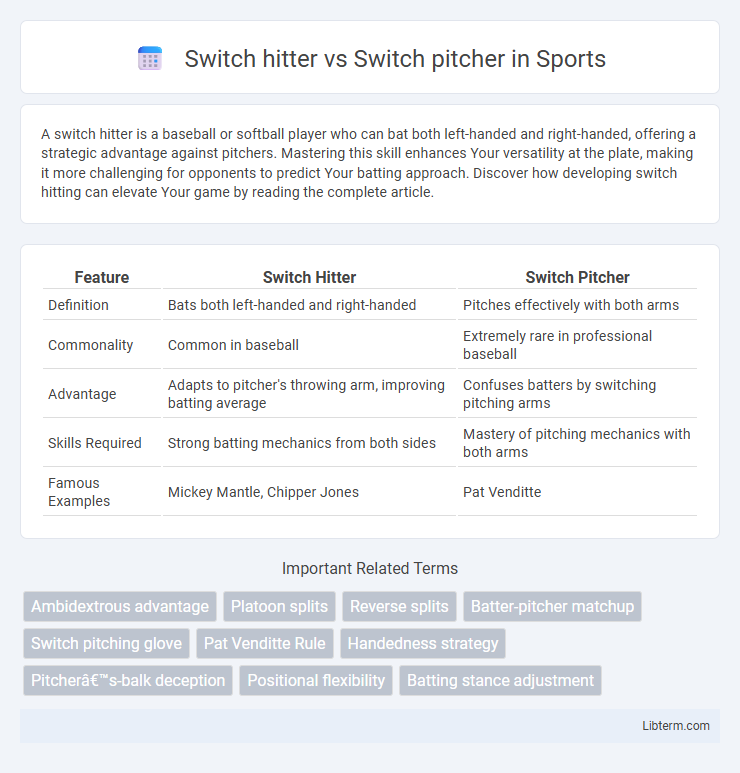A switch hitter is a baseball or softball player who can bat both left-handed and right-handed, offering a strategic advantage against pitchers. Mastering this skill enhances Your versatility at the plate, making it more challenging for opponents to predict Your batting approach. Discover how developing switch hitting can elevate Your game by reading the complete article.
Table of Comparison
| Feature | Switch Hitter | Switch Pitcher |
|---|---|---|
| Definition | Bats both left-handed and right-handed | Pitches effectively with both arms |
| Commonality | Common in baseball | Extremely rare in professional baseball |
| Advantage | Adapts to pitcher's throwing arm, improving batting average | Confuses batters by switching pitching arms |
| Skills Required | Strong batting mechanics from both sides | Mastery of pitching mechanics with both arms |
| Famous Examples | Mickey Mantle, Chipper Jones | Pat Venditte |
Introduction to Switch Hitter and Switch Pitcher
A switch hitter is a baseball player who can bat both right-handed and left-handed, providing strategic advantages against pitchers of either hand. A switch pitcher, though extremely rare, is a pitcher capable of throwing with both the right and left arms, allowing tactical flexibility during a game. Both roles enhance a team's adaptability and can disrupt the opponent's pitching or hitting approach.
Defining a Switch Hitter in Baseball
A switch hitter in baseball is a batter proficient in hitting from both right and left sides of the plate, allowing strategic flexibility against opposing pitchers. This skill enhances matchup advantages by mitigating pitcher dominance based on batter handedness. Unlike a switch pitcher who can pitch with either arm, a switch hitter's primary role is offensive adaptability to increase hitting effectiveness.
Understanding the Role of a Switch Pitcher
A switch pitcher can throw effectively with both the left and right arms, creating strategic advantages by disrupting the batter's timing and increasing matchup flexibility. Unlike the well-known switch hitter who can bat from either side of the plate, switch pitchers are rare and require extensive ambidextrous skill development and training. Their unique ability to alternate pitching arms allows managers to exploit platoon splits and maximize pitch effectiveness against diverse batters.
Historical Background and Notable Players
Switch hitters gained prominence in Major League Baseball during the early 20th century, with legends like Mickey Mantle and Chipper Jones showcasing the strategic advantage of batting from both sides to counter pitchers' strengths. Switch pitchers remain exceedingly rare, with Pat Venditte being the most notable modern player, known for his ambidextrous pitching which disrupts hitters' timing and matchups. The historical evolution of switch hitting reflects widespread adoption and success, whereas switch pitching remains a niche skill that challenges traditional pitching norms.
Strategic Advantages of Switch Hitters
Switch hitters offer a strategic advantage by allowing teams to maintain optimal batting matchups against both left- and right-handed pitchers, minimizing platoon disadvantages. Their ability to bat from both sides of the plate disrupts pitching strategies and reduces the effectiveness of bullpen specialization. This versatility enhances lineup flexibility, enabling managers to adapt swiftly to in-game pitching changes without compromising offensive potential.
Unique Challenges Facing Switch Pitchers
Switch pitchers face distinct challenges due to the rarity and complexity of mastering effective pitching mechanics with both arms, requiring balanced strength, coordination, and endurance. Unlike switch hitters who primarily adjust hitting stance, switch pitchers must also maintain consistent pitch velocity, control, and deception from each arm, complicating strategic game management and bullpen usage. The scarcity of switch pitchers in professional baseball intensifies pressure to prove reliability and adapt quickly to diverse batter matchups with both arms.
Famous Game Moments: Switch Hitter vs Switch Pitcher
Switch hitters like Mickey Mantle and Chipper Jones have famously challenged switch pitchers such as Pat Venditte, creating rare and strategic matchups in Major League Baseball. One memorable moment occurred in 2008 when Venditte, known for pitching ambidextrously, faced switch hitter Ralph Henriquez, leading to a standoff where Venditte had to choose pitching arms multiple times to gain the advantage. These encounters highlight the unique tactical battle between switch hitters and switch pitchers, showcasing adaptability and split-second decisions that have shaped iconic game moments.
Rules and Regulations Affecting Gameplay
Switch hitters are batters who can hit proficiently from both the left and right sides of the plate, with MLB rules allowing them to change batting stance during an at-bat without penalty. Switch pitchers, rarer in professional play, can pitch with either hand but must adhere to the "Pat Venditte Rule," which requires them to declare the pitching arm before each batter, preventing mid-batter arm changes. These regulations balance strategic flexibility with fairness, directly impacting in-game decisions and matchups in Major League Baseball.
Training and Skill Development for Switch Athletes
Switch hitters and switch pitchers require specialized training regimens that emphasize bilateral coordination, muscle memory, and ambidextrous skill development to maximize performance in baseball. Drills for switch hitters focus on developing equal hitting power, timing, and vision from both sides of the plate, enhancing adaptability against diverse pitching styles. Switch pitchers undergo rigorous training to build arm strength, mechanics, and control in both arms, improving pitch variety and endurance, which demands careful management to prevent injury and optimize competitive advantage.
Future Impact and Evolution in Baseball
Switch hitters have revolutionized offensive strategy by providing lineup flexibility and increasing matchup advantages against pitchers, leading to sustained offensive innovation. Switch pitchers remain rare but could significantly impact pitching dynamics if developed, offering teams unprecedented versatility and strategic depth. The future of baseball may see enhanced training methods and analytics driving the evolution of both skills, fundamentally reshaping player roles and game tactics.
Switch hitter Infographic

 libterm.com
libterm.com